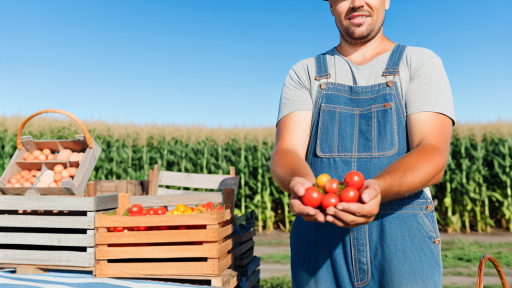Understanding Local Food Systems
Importance of Local Food Systems
Local food systems play a vital role in community health.
They foster economic development by supporting local farmers.
Additionally, these systems shorten the supply chain.
As a result, fresh produce reaches consumers more quickly.
This enhances food quality and flavor.
Moreover, local food promotes environmental sustainability.
It reduces carbon footprints associated with transportation.
Benefits of Sourcing Locally
Sourcing food locally offers numerous advantages.
First, it strengthens local economies.
Spending on local products keeps money within the community.
Second, it builds relationships among consumers and producers.
These relationships can increase transparency in food sourcing.
Furthermore, local agriculture supports biodiversity.
Diverse crops contribute to resilient ecosystems.
Challenges in Local Food Sourcing
While beneficial, local food sourcing has challenges.
Transform Your Agribusiness
Unlock your farm's potential with expert advice tailored to your needs. Get actionable steps that drive real results.
Get StartedSeasonality can limit the availability of certain products.
Additionally, small-scale farmers often face competition.
They struggle against larger agricultural enterprises.
Moreover, awareness and education about local options may be lacking.
The Role of Community Engagement
Community engagement enhances local food systems.
Events like farmers’ markets create connections between consumers and producers.
Education efforts on nutrition and sourcing are equally important.
These initiatives foster a supportive environment for local agriculture.
By engaging communities, local food systems can thrive and expand.
Identifying Target Markets
Understanding Your Customer Base
Identifying your target market is crucial for a local food sourcing business.
First, you should consider who will buy your products.
Look into demographics such as age, income, and location.
For instance, millennials often prioritize sustainable food sources.
Also, families may seek fresh produce for healthier meals.
Segmenting the Market
Segmenting your market helps tailor your offerings.
You can categorize customers into different groups.
- Health-conscious consumers who prefer organic options.
- Restaurants seeking local ingredients for their menus.
- Schools and institutions interested in farm-to-table programs.
Each segment has distinct needs and preferences.
Understanding these can enhance your marketing efforts.
Researching Competitors
Analyzing competitors can reveal potential customer insights.
Review their target markets and customer engagement strategies.
This research can guide your positioning within the market.
Consider gathering feedback from local consumers.
Surveys and focus groups can yield valuable data.
Building Relationships
Relationships with local communities are vital.
Showcase Your Farming Business
Publish your professional farming services profile on our blog for a one-time fee of $200 and reach a dedicated audience of farmers and agribusiness owners.
Publish Your ProfileEngage with customers through workshops or events.
Offer tastings to showcase your products and build loyalty.
Networking can also open doors for partnerships.
Collaborate with local chefs or health organizations.
Utilizing Social Media
Leverage social media to reach potential customers.
Platforms like Instagram and Facebook allow for targeted advertising.
Share stories about your sourcing practices and farmers.
Engagement with followers can create a dedicated community.
Use these platforms to promote local markets and events.
Sourcing Products
Finding Local Growers
Start by identifying farms in your area.
Visit local farmers’ markets to meet growers.
Engage with local agricultural cooperatives for connections.
Attend food festivals that feature local produce.
Utilize online directories dedicated to local food sourcing.
Connecting with Artisanal Producers
Seek out local artisans who produce specialty foods.
Visit farm-to-table restaurants for supplier leads.
Network with chefs who prioritize local ingredients.
Collaborate with regional food artisan guilds for partnerships.
Building Relationships with Suppliers
Nurture your connections with regular communication.
Ensure that you understand their production cycles.
Discuss the quality standards you expect from them.
Offer to promote their products to build goodwill.
Leveraging Technology for Sourcing
Consider using social media to discover local producers.
Utilize apps designed to connect businesses with local farmers.
Submit inquiries on platforms specific to food sourcing.
Engage with community-supported agriculture (CSA) programs.
Delve into the Subject: How Farmers Can Embrace Local Food Sourcing
Building Relationships: Networking with Local Farmers and Suppliers
Understanding the Importance of Local Connections
Building relationships with local farmers is crucial for your business model.
These connections foster trust and reliability in your sourcing process.
Moreover, they can lead to exclusive deals and fresh product availability.
Identifying Potential Partners
Start by researching local farms that align with your sourcing goals.
Visit farmers’ markets and local food events to meet potential suppliers.
Ask for recommendations from other local businesses in your area.
Approaching Farmers and Suppliers
When approaching farmers, present your business clearly and confidently.
Share your vision for sourcing local products and supporting the community.
Be genuine in your interest to learn more about their farming practices.
Creating Sustainable Relationships
Communicate regularly with your partners to strengthen your collaboration.
Offer feedback and support to help them improve their operations.
Encourage open discussions about challenges and innovations in the field.
Utilizing Technology for Networking
Leverage social media platforms to connect with local farmers and suppliers.
Showcase Your Farming Business
Publish your professional farming services profile on our blog for a one-time fee of $200 and reach a dedicated audience of farmers and agribusiness owners.
Publish Your ProfileJoin online community groups focused on sustainable food sourcing.
Use apps dedicated to farm-to-table connections to expand your network.
Participating in Local Events
Engage in local agricultural events and workshops to meet potential partners.
Attend farm tours to gain insights into their operations firsthand.
These experiences build rapport and demonstrate your commitment to local sourcing.
Establishing Formal Partnerships
Consider writing contracts that outline the terms of your partnership.
Be clear about expectations, pricing, and delivery schedules.
Review and adjust agreements as necessary to reflect changing market conditions.
Find Out More: Implementing Local Food Sourcing in Your Farming Plan
Logistics and Distribution
Planning the Supply Chain
Effective planning enhances supply chain efficiency.
Identify key suppliers within your local area.
Engage directly with local farmers and producers.
This connection fosters stronger relationships.
Map out the logistics involved in the sourcing process.
Consider transportation needs for timely deliveries.
Evaluate the best transportation methods to use.
Options include local trucks or bicycle delivery services.
Streamlining communication is also essential.
Use inventory management systems to track stock levels.
Inventory Management
Implementing robust inventory management is vital.
Regularly assess stock levels to avoid shortages.
Consider implementing a just-in-time inventory system.
This approach minimizes storage costs effectively.
Utilize software solutions for real-time updates.
These platforms can enhance decision-making speed.
Distribution Strategies
Define distribution channels appropriate for your market.
Explore options like direct sales or farmer’s markets.
Online sales platforms can also broaden your reach.
Evaluate the cost-effectiveness of each distribution method.
Innovative strategies can boost competitiveness.
Partnerships and Collaborations
Form partnerships with local businesses for mutual benefit.
Collaborate with restaurants that emphasize local sourcing.
Shared marketing efforts can amplify your reach.
Consider joining local food co-ops or networks.
These alliances can improve visibility and trust.
Monitoring and Assessment
Continuously monitor supply chain performance metrics.
Key performance indicators indicate areas for improvement.
Regular assessments facilitate responsive adjustments.
Solicit feedback from customers and suppliers regularly.
This feedback loop can enhance overall efficiency.
Showcase Your Farming Business
Publish your professional farming services profile on our blog for a one-time fee of $200 and reach a dedicated audience of farmers and agribusiness owners.
Publish Your ProfileYou Might Also Like: Farm Fresh: How Small Farms Are Building Stronger Local Communities

Marketing Strategies
Understanding Your Audience
Identify your target customers effectively.
Conduct surveys to gather insights about their preferences.
Analyze trends in local food consumption to refine your strategy.
Building a Strong Brand
Create a memorable brand that reflects your values.
Develop a unique logo to enhance brand recognition.
Consistently share your brand story across all platforms.
Utilizing Social Media
Engage actively with customers on popular platforms.
Share behind-the-scenes content showcasing local farms.
Highlight customer testimonials to build trust.
Hosting Local Events
Organize events to foster community engagement.
Collaborate with local farmers for farm-to-table dinners.
Offer cooking workshops featuring local ingredients.
Creating Partnerships
Network with local businesses to strengthen your reach.
Collaborate with restaurants that prioritize local sourcing.
Form alliances with farmers’ markets to highlight your offerings.
Implementing Loyalty Programs
Design loyalty programs that reward repeat customers.
Offer discounts or perks for referrals to encourage participation.
Use email marketing to promote exclusive deals for members.
Educational Content Marketing
Provide valuable content about local food sourcing.
Write blog posts on the benefits of eating locally.
Produce videos showcasing how to prepare local dishes.
Optimizing Your Online Presence
Ensure your website is user-friendly and informative.
Utilize SEO strategies to improve search engine rankings.
Incorporate an online store to facilitate easy purchases.
Gathering Customer Feedback
Encourage customers to leave reviews on your platforms.
Use surveys after purchases to assess customer satisfaction.
Adapt based on feedback to continuously improve your services.
Discover More: Beyond Organic: How Farm-to-Table Is Evolving with Consumer Demands
Setting Pricing Models
Understanding the Dual Challenges
Creating a sustainable pricing model is essential for local food sourcing businesses.
The aim is to balance affordability with the costs of sustainable practices.
First, consider the importance of sourcing high-quality, local ingredients.
This can often lead to higher costs compared to mass-produced options.
However, consumers are increasingly valuing transparency and sustainability.
Researching Local Market Dynamics
Start by analyzing local market conditions and consumer needs.
Identify competitors and their pricing strategies for similar offerings.
Survey potential customers about their willingness to pay for local foods.
This data will help inform your pricing strategy effectively.
Incorporating Costs and Sustainable Practices
Calculate all operational costs that contribute to pricing.
Include expenses like labor, transportation, and packaging.
Showcase Your Farming Business
Publish your professional farming services profile on our blog for a one-time fee of $200 and reach a dedicated audience of farmers and agribusiness owners.
Publish Your ProfileFactor in the premiums associated with sustainable farming practices.
Moreover, evaluate how these costs influence your pricing model.
Creating Value for Customers
Communicate the added value of sourcing locally and sustainably.
Share stories behind the foods you offer and the farmers who produce them.
Highlight the health and environmental benefits of your products.
This transparency can justify higher prices in the eyes of customers.
Implementing Diverse Pricing Strategies
Consider introducing tiered pricing options for various customer segments.
For example, offer subscription services or bundles for regular customers.
Additionally, explore discounts for bulk purchases to attract more buyers.
Flexibility in pricing can accommodate different budgets while promoting sustainability.
Regularly Evaluating Pricing Models
Continuously assess and adjust your pricing based on feedback and performance.
Stay informed about changes in the cost of local ingredients.
Furthermore, monitor shifts in customer preferences and market trends.
Adaptability will ensure your pricing model remains both fair and effective.
Legal Considerations
Understanding Permits
Starting a local food sourcing business requires specific permits.
Each local jurisdiction may have different permit requirements.
Research the permits relevant to food handling and storage.
Additionally, some areas may require business licenses.
Regulations for Food Safety
Food safety regulations protect consumers from harmful practices.
Familiarize yourself with the regulations in your region.
Your sourcing methods must comply with safety protocols.
Ensure that all products meet state and federal health standards.
Compliance with Local Laws
Local laws govern agricultural practices and food distribution.
Stay updated on any changes in the local agricultural regulations.
Networking with local farmers can provide insights into compliance issues.
Documentation is essential for compliance checks.
Insurance Considerations
Obtaining proper insurance is crucial for your business.
Consider general liability insurance to protect against risks.
Product liability insurance is also necessary for food businesses.
Consult a legal expert to discuss your specific insurance needs.
Additional Resources
Things to think about before purchasing a Freight Farm | by Connor …
Why Farm-to-Institution Sourcing is the Sleeping Giant of Local Food …




